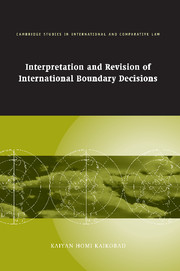Book contents
- Frontmatter
- Contents
- List of maps
- Preface
- Acknowledgments
- Table of cases
- List of abbreviations
- Part I Introduction
- Part II The settlement of territorial and boundary disputes
- Part III Judicial remedies: interpretation
- Part IV Judicial remedies: revision
- 7 The revision of judgments and awards
- 8 General features of revision
- 9 The classification of the notion of revision
- 10 Issues of admissibility
- 11 Selected substantive and procedural aspects of revision
- Part V Conclusions
- Select bibliography
- Index
- CAMBRIDGE STUDIES IN INTERNATIONAL AND COMPARATIVE LAW
11 - Selected substantive and procedural aspects of revision
Published online by Cambridge University Press: 14 September 2009
- Frontmatter
- Contents
- List of maps
- Preface
- Acknowledgments
- Table of cases
- List of abbreviations
- Part I Introduction
- Part II The settlement of territorial and boundary disputes
- Part III Judicial remedies: interpretation
- Part IV Judicial remedies: revision
- 7 The revision of judgments and awards
- 8 General features of revision
- 9 The classification of the notion of revision
- 10 Issues of admissibility
- 11 Selected substantive and procedural aspects of revision
- Part V Conclusions
- Select bibliography
- Index
- CAMBRIDGE STUDIES IN INTERNATIONAL AND COMPARATIVE LAW
Summary
Preliminary observations
In this final chapter it is intended to examine three salient aspects of revision. The first is the very real problem of reconciling the legal effects and implications of two conflicting aspects of international law, namely, the basic rule of res judicata and the remedy of revision. While the former axiom refuses to countenance, in all the appropriate circumstances, a re-examination of an existing judgment or award, the latter, where admitted, could in many cases lead to re-examination. This issue was considered in the context of interpretation in Chapter 5 above. Here, in the context of revision, it will suffice to consider the matter in some detail with a view to clarifying and reconciling these conflicting positions.
The second issue discussed below seeks to explain the impact of what, for want of a better description, may be referred to as ‘indirect delimitation’, on the remedy of revision. However, in view of the fact that indirect delimitation is not the technique States normally choose to resolve their boundary disputes, it will be appropriate to consider an appreciation of the limits of revision in this kind of request for delimitation.
The third and final issue examined in this context is predicated on the view that it is necessary to seek an understanding of the scope of the precise task of the tribunal once it has determined that a newly discovered fact is clearly decisive in terms of being crucial to the judgment or award.
- Type
- Chapter
- Information
- Interpretation and Revision of International Boundary Decisions , pp. 302 - 322Publisher: Cambridge University PressPrint publication year: 2007

